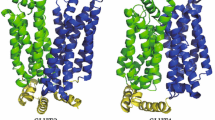Abstract.
The four-state simple carrier model (SCM) is employed to describe ligand translocation by diverse passive membrane transporters. However, its application to systems like facilitative sugar transporters (GLUTs) is controversial: unidirectional fluxes under zero-trans and equilibrium-exchange experimental conditions fit a SCM, but flux data from infinite-cis and infinite-trans experiments appear not to fit the same SCM. More complex kinetic models have been proposed to explain this ``anomalous'' behavior of GLUTs, but none of them accounts for all the experimental findings. We propose an alternative model in which GLUTs are channels subject to conformational transitions, and further assume that the results from zero-trans and equilibrium-exchange experiments as well as trans-effects corresponds to a single-occupancy channel regime, whereas the results from the infinite-cis and infinite-trans experiments correspond to a regime including higher channel occupancies. We test the plausibility of this hypothesis by studying a kinetic model of a two-site channel with two conformational states. In each state, the channel can bind the ligand from only one of the compartments. Under single-occupancy, for conditions corresponding to zero-trans and equilibrium-exchange experiments, the model behaves as a SCM capable of exhibiting trans-stimulations. For a regime including higher degrees of occupancy and infinite-cis and infinite-trans conditions, the same channel model can exhibit a behavior qualitatively similar to a SCM, albeit with kinetic parameters different from those for the single-occupancy regime. Numerical results obtained with our model are consistent with available experimental data on facilitative glucose transport across erythrocyte membranes. Hence, if GLUTs are multiconformational channels, their particular kinetic properties can result from transitions between single and double channel occupancies.
Similar content being viewed by others
Author information
Authors and Affiliations
Additional information
Received: 12 April 1995/Revised: 28 August 1995
Rights and permissions
About this article
Cite this article
Hernández, J., Fischbarg, J. & Vera, J. Modeling Facilitative Sugar Transporters: Transitions Between Single and Double Ligand Occupancy of Multiconformational Channel Models Explain Anomalous Kinetics. J. Membrane Biol. 149, 57–69 (1996). https://doi.org/10.1007/s002329900007
Issue Date:
DOI: https://doi.org/10.1007/s002329900007




